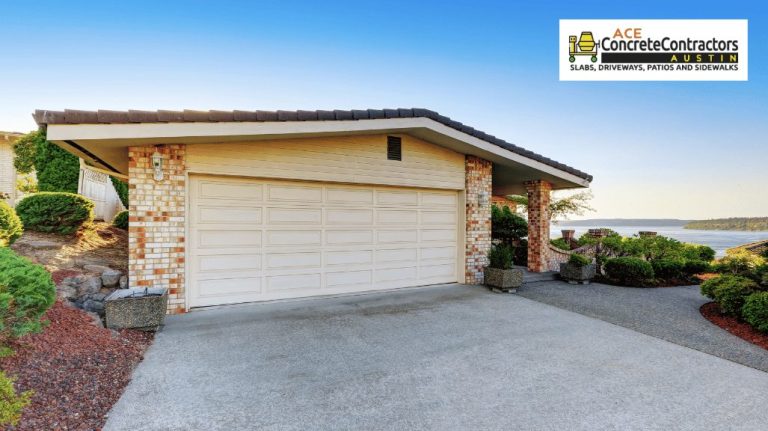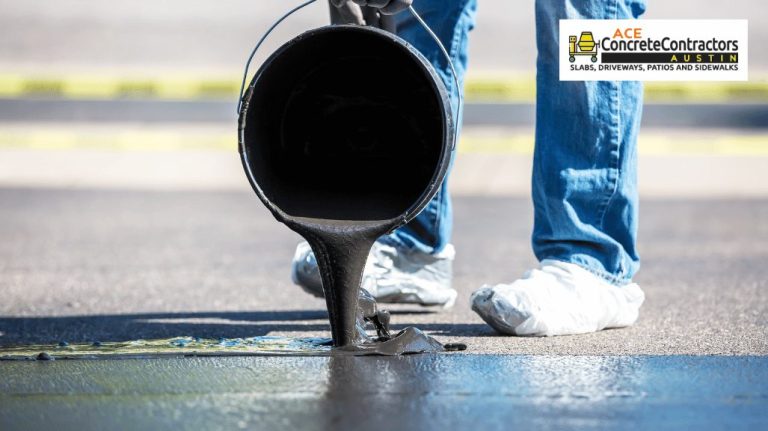Table of Contents
Concrete driveways endure plenty as the seasons change each year. You’ll likely deal with the heaviness of vehicles, shovels, oil stains, and fluctuating temperatures, which will all take their toll. However, a little maintenance and care will protect your driveway throughout the future.
The best way to protect concrete from the wear and tear it will likely see is to use a concrete sealant. Whenever it’s applied correctly, it will improve the durability and appearance of your concrete.
Likewise, sealing concrete driveways will help to prevent cracking, mold, and stains. Plus, if the concrete is damaged, you can quickly repair cracks using this option.
However, it would be best if you weren’t repairing cracks in the home’s foundation because they are more severe and will require a professional inspection.
Overall, if your concrete is stained, fading, or cracked, it’s time to consider resealing and repairing before the rain and winter come along. Ace Concrete Contractors is here to help you get the job done right. Today, you’ll learn a few tips to help you seal your concrete slab. Let’s get started!
Seal the Deal: Your Ultimate Guide to Concrete Driveway Sealing! 🚗✨ Dive in and discover everything you need to know at https://t.co/yzT83jwNCe #ConcreteSealing #HomeMaintenance #AustinTx #concrete pic.twitter.com/8VjYNCIVrV
— Ace Concrete Contractors Austin (@aceconcreteatx) January 12, 2024
Should You Seal Concrete Driveways?
You aren’t required to use a concrete sealer, but it’s highly recommended. Sealing your concrete will preserve its longevity and help it retain its natural beauty. Plus, water cannot get into it and cause damage. Overall, you’ll prevent issues and have a nicer-looking driveway, and it will save money because you won’t have as many repairs.
Because it’s a protective coating, it shields the concrete from stains and the elements, making it easier to clean away grease, oil, and more. If you’re in a location that sees more ice or cold weather, avoid deicing salts on the concrete because the chemicals will ultimately wear down the protective coating of your sealed driveway. For a more detailed breakdown and expert tips, check out our full guide on Sealing Concrete Driveways.
Types of Sealers
Penetrating sealers form a permanent chemical bond with your substrate. Likewise, they won’t wear down until the substrate is gone, so it lasts many years without much maintenance.
There are four types of penetrating sealers:
- Silane – This lasts 10 to 25 years, is the deepest penetrating sealer, and is the most expensive.
- Siliconate – This will also last simultaneously and is ideal for curing new concrete and blocking out moisture.
- Silicate – This lasts about 10 to 25 years and is ideal for polished concrete.
- Siloxane – This has a shorter lifespan of three to five years and doesn’t penetrate deeply.
Many homeowners will use siliconate penetrating sealers because they suit ponds, residential driveways, statues, fountains, and other structures.
Though penetrating sealers are clear and have no gloss or enhancement, there are also topical sealers, which will add a more decorative element. They protect from chemicals, stains, gas, grease, and oil. However, they vary in appearance and longevity based on the type of driveway sealer.
Here are the main options:
- Acrylic Sealers – These get reapplied every one to three years but are easy to apply and cost-effective. Plus, they’ll protect the concrete from rain, UV rays, mildew, and mold.
- Epoxy – This is the most chemically-resistant option and gets reapplied every five to 10 years.
- Urethane – With this, you get the highest abrasion resistance, but you’ll need an epoxy primer and will also reapply it every five to 10 years.
- Hybrid/Blended – These coatings combine two or more of the resins listed above to make applying and achieving higher resistance easier.
You will choose either a penetrating sealer or a topical one; you don’t need both! Always read the manufacturer’s instructions before putting the sealer on the surface of the concrete.
How to Apply Sealer to the Concrete
Once your concrete has finished curing, it’s wise to protect it with a concrete sealer.
When the slab is cured, which takes about 28 days, you’ll have to check the weather forecast. It’s best to seal concrete whenever it’s dry and warm. Therefore, the temperatures should be above 50 degrees Fahrenheit for eight full hours and over 32 degrees Fahrenheit for 24 hours after that.
To properly seal concrete, follow these steps:
1. Thoroughly Clean Your Concrete
Remove the stains, grease, dirt, and oil from your concrete. If you don’t, the sealer will seal in the discoloration and dirt so they won’t be removable later. Plus, the sealer might not adhere to it well.
Use a cleaner to remove the existing sealer and stains, including mildew, mold, mastic, paint, grease, and oil. The concrete cleaner you choose depends on the type of stain. Usually, professionals recommend getting the concrete super clean using a pressure washer with a 25-degree fan tip and 3,500 PSI. Hold the wand about 6 to 8 inches from the concrete’s surface, moving in even, slow sweeps.
Allow the concrete to dry for about 24 hours before you apply the sealer, using that time to fill in any cracks you hope to repair. Smooth your concrete repair sealant over the cracks using a putty knife, reading the manufacturer’s instructions for proper drying times.
2. Strip Away Existing Concrete Sealers from the Surface
It’s best to use a solvent-based stripping solution. Spread a thick coat evenly on your concrete with a paint sprayer, following all the directions on your product.
3. Use the Etching Solution
You want to ensure that your sealer adheres to the concrete effectively. Therefore, it’s wise to utilize an etching solution to open it up. Read the directions and choose the best method of application.
4. Apply Concrete Sealer
Make sure you’re in a well-ventilated area, and then apply a thin coat of your sealant to your concrete with a sprayer or roller. The tool you choose depends on your sealant type (solvent- or water-based). Usually, the instructions will have a few suggestions to help you.
Remember that less is more when you’re applying sealant. You want it even and thin.
5. Apply Your Second Coat
Your sealant must dry for at least two hours before you apply the second thin coat. When you put on the second coat, put it in the opposite direction from the first to ensure that coverage is consistent.
How Long to Wait Before Driving on Sealed Concrete
Your concrete sealant must be fully dried before you can drive on it, which might take three days. However, read the manufacturer’s instructions to learn about drying times.
Resurfacing Concrete
If you have old concrete, you can use a concrete resurfacer to deal with spalling (pits and crumbling) and worn-out driveways, patios, walkways, and other concrete surfaces.
Thoroughly clean and patch the spalled areas, use the resurfacer solution to fill in the pits, and smooth it all out with a trowel. When the patch is thoroughly dried, you can resurface your concrete. It’s wise to use peel-and-stick foam, such as weather stripping products, to cover the joints before resurfacing.
You’ll mix and pour a small amount of product, spreading it with a trowel to 1/8-inch or 1/4-inch thick. If you require a slip-resistant finish, wait about five minutes and use a nylon broom that goes against the direction of your foot traffic. Let everything dry for about six hours before doing anything. Likewise, if you fear weather exposure from rain, cover the surface quickly!
Sealing Concrete Cracks
When you seal cracks in a concrete driveway, you must remove the loose concrete and debris with a wire brush and screwdriver. Then, sweep everything and use a leaf blower to remove every last bit. Fill the crack with repair caulk.
Why Hire a Professional Concrete Contractor
Using a concrete driveway sealer isn’t necessarily difficult, but it’s often challenging for homeowners. They aren’t familiar with the tools and products and may utilize the wrong one on a surface that sees heavy traffic.
It’s best to call a professional contractor when sealing your driveway. Ace Contractors, Inc. is an ideal solution. Please call 615.568.0060 to request an inspection today!
Read More How to Fix Cracks in Concrete Patio
FAQs
Do I Need to Seal My Concrete Driveway?
Living in a climate with frequent cold/warm cycles can be problematic for concrete surfaces. Liquid can get into the cracks, expanding quickly. Even if it takes a bit longer for cracks to show up, it will happen, leaving the surface destroyed. To better understand how these temperature fluctuations affect your surface, read more about why concrete cracks.
Overall, it’s best to use a concrete sealer to protect it from stains, discoloration, and damage from salt, oil, and other chemicals.
Can You Seal a Concrete Driveway By Yourself?
It depends on your project. However, most homeowners find it more time-consuming and challenging to seal concrete driveways themselves. You might require special tools and a professional to apply them, and you may not know how to do it yourself.
What Should I Use to Seal My New Concrete Driveway?
You’ll need a concrete sealer to seal your concrete driveway; most experts recommend a penetrating sealer.
What Is the Downside of Sealing Concrete?
Though there are countless benefits of sealing a concrete surface, there are a few disadvantages to keep in mind:
- Slippery Surface – Sealants often dry to a semi-glossy sheen, which could be slick when wet. However, some products feature abrasive additives to counteract that.
- Reapplication – Sealants won’t last forever, so you’ve got to reapply them periodically.
- Added Expense – It costs nothing if you don’t seal your driveway, but you’ll spend money to do so every three to five years.






